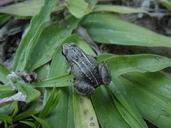|
Description
Eleutherodactylus varleyi is a tiny frog, with adult females measuring up to 17 mm in SVL and males up to 14 mm. The skin of the dorsum is tuberculate, but without a pair of paravertebral folds at mid-dorsum. The venter is partially areolate, becoming gradually smooth toward the chest. The digital discs are very small. There is no webbing between the toes. The vomerine teeth, behind the choanae, are in a curved series (Dunn 1925; Ruiz 1987; Schwartz and Henderson 1985; Schwartz and Henderson 1991). These frogs are very variable in color. They may be unicolor tan, grayish or reddish brown with a median light line and a pair of light (bronzy tan) dorsolateral lines. Sometimes they are irregularly mottled with one or two indistinct dark chevrons. The sides are gray. At times an interorbital triangle is present, continuing as a dark median dorsal band. There is a pair of poorly defined scapular spots. The venter is white with scattered, black granules, giving a dusky effect (Dunn 1925; Ruiz 1987; Schwartz and Henderson 1985; Schwartz and Henderson 1991). Distribution and Habitat
Country distribution from AmphibiaWeb's database: Cuba
This species is endemic to Cuba and Isla de la Juventud. It is found island-wide, from sea level to about 1400 m. It occurs under trash, leaf litter and other surface debris of woods, shrubs, coffee plantations, towns and other human situations (Schwartz and Henderson 1991). Life History, Abundance, Activity, and Special Behaviors
This is a terrestrial species, found at night on ground, commonly in grasses. Males vocalize from grass blades or from the ground. There are two basic patterns of calls. The first pattern is comprised of relatively soft calls of two notes (“tuc-tic”). These are broadcast at different levels of frequency and with three to four notes calls inserted sporadically, possibly carrying a territorial message. The second pattern consists of loud, more metallic calls (“pic”), composed primarily of single notes, sometimes two. There are also sporadic trains with 3–7 notes (possibly territorial calls) (Estrada 1987; Ruiz 1987; Schwartz and Henderson 1991; Diaz et al. 2003). This frog is a direct developing species, ovipositing in earth among grass. Clutches are composed of about four eggs, 3.5-4.0 mm in diameter. Females seem to care for the clutch (Estrada 1987; Ruiz 1987; Schwartz and Henderson 1991; Diaz et al. 2003). Possible reasons for amphibian decline General habitat alteration and loss
Comments
Eleutherodactylus varleyi is a member of the subgenus Euhyas (Heinicke et al. 2007). Etymology- Named after James B. Varley, who helped the author to collect the type specimens (Dunn 1925). Synonyms include Eleutherodactylus phyzelus (Schwartz 1958).
References
Diaz, L. M., Cadiz, A. and Hedges, S. B. (2003). ''A new grass frog from pine forests of Western Cuba, and description of acoustic and pattern variation in Eleutherodactylus varleyi (Amphibia: Leptodactylidae).'' Caribbean Journal of Science, 39(2), 176-188.
Dunn, E. R. (1925). ''New frogs from Cuba.'' Occasional Papers of the Boston Society of Natural History, 5, 163-166.
Estrada, A. R. (1987). ''Los nidos terrestres de dos especies de Eleutherodactylus (Anura: Leptodactylidae).'' Poeyana, 352, 1-9.
Heinicke, M. P., Duellman, W. E., Hedges, S. B. (2007). ''Major Caribbean and Central American frog faunas originated by ancient oceanic dispersal.'' Proceedings of the National Academy of Sciences of the United States of America, 104(24), 10092-10097.
Ruiz, F. N. (1987). Anfibios de Cuba. Cientifíco-Técnica, La Habana.
Schwartz, A. (1958). ''Four new frogs of the genus Eleutherodactylus (Leptodactylidae) from Cuba.'' American Museum Novitates, 1873, 1-20.
Schwartz, A., and Henderson, R. W. (1985). A Guide to the Identification of the Amphibians and Reptiles of the West Indies Exclusive of Hispaniola. Milwaukee Public Museum, Inland Press, Milwaukee.
Schwartz, A., and Henderson, R. W. (1991). Amphibians and Reptiles of the West Indies. Descriptions, Distributions, and Natural History. University of Florida Press, Gainesville, Florida, USA.
Originally submitted by: Ansel Fong G. (first posted 2007-11-07)
Edited by: Kellie Whittaker (2007-11-12)Species Account Citation: AmphibiaWeb 2007 Eleutherodactylus varleyi: Western Cuba Grassfrog <https://amphibiaweb.org/species/3265> University of California, Berkeley, CA, USA. Accessed Nov 7, 2024.
Feedback or comments about this page.
Citation: AmphibiaWeb. 2024. <https://amphibiaweb.org> University of California, Berkeley, CA, USA. Accessed 7 Nov 2024.
AmphibiaWeb's policy on data use.
|
